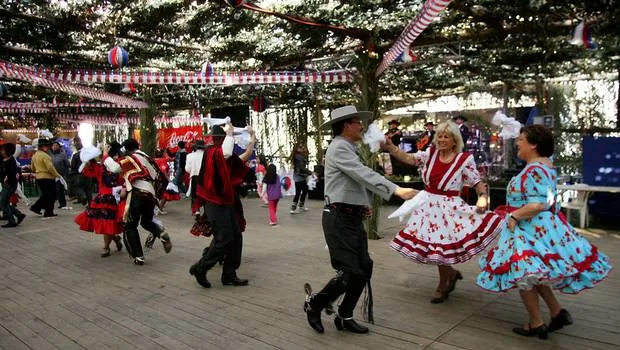- Get link
- Other Apps
Written By: Raúl Silva M.
Chile's Independence Day, popularly known as "el Dieciocho", takes place every 18 September, and depending on what day of the week the date falls, the celebrations can also include from 17 to 20 September. What it is actually commemorated is the creation of the First Government Junta on September 18, 1810, the first autonomous form of government emerged in Chile. The next day (19th) is celebrated "The Day of the Glories of the Army", with a Military Parade that takes place every year in the O'Higgins Park of Santiago, in the presence of the highest authorities of the country and people in general.
"Ramadas" and "Fondas"
 |
| Celebration of the National Day with typical garments Image: 24horas.cl |
As for gastronomy, the "Chilean "Empanadas" are the most famous and traditional food. It consists of a dough either fried or baked stuffed with ground beef, onion, raisins, boiled egg and an olive. Also famous are the "Cazuela de Ave", a very filling chicken or hen soup, the "Anticuchos" (Chilean style Brochettes) with beef, chicken, sausage, chorizo, onions, peppers besides the Chilean Roasts, Barbecues and the Choripan, a combined word to describe a chorizo in a piece of bread.
Apart from the different types of wine, of which Chile is a major producer, the most requested drinks by those attending the Fondas and Ramadas are the Chicha, the Vino Pipeño (special kind of wine fermented in barrels), the "Terremoto" (Earthquake), a drink prepared from Pipeño wine, pineapple ice cream and grenadine, created by the people's ingenuity shortly after the earthquake in Chile in 1985. Its name refers to the effect produced after drinking it...., even another drink is the "Replica" (afterschock).
Another activity within the National Day (18 September) is the Te Deum, liturgy of Thanksgiving which takes place at 11.00 AM at the Metropolitan Cathedral of Santiago, with the presence of the highest authorities of the country, led by the President of the Republic.
Other activities
Apart from the different types of wine, of which Chile is a major producer, the most requested drinks by those attending the Fondas and Ramadas are the Chicha, the Vino Pipeño (special kind of wine fermented in barrels), the "Terremoto" (Earthquake), a drink prepared from Pipeño wine, pineapple ice cream and grenadine, created by the people's ingenuity shortly after the earthquake in Chile in 1985. Its name refers to the effect produced after drinking it...., even another drink is the "Replica" (afterschock).
Another activity within the National Day (18 September) is the Te Deum, liturgy of Thanksgiving which takes place at 11.00 AM at the Metropolitan Cathedral of Santiago, with the presence of the highest authorities of the country, led by the President of the Republic.
Other activities
| Military Parade at Parque O'Higgins |
There is also fun for the family, in many schools are organized fund-raising events known as the Kermeses, in Parks and Avenues you can also see the children raising their kites, taking advantage of the spring breeze that is already coming. Another traditional activity of this period, which for decades has been considered the National Sport is the Chilean Rodeo, although lately it has been questioned by the animal abuse that this sport might imply. This traditional activity is practiced in Chile since colonial times, so it is considered among the most typical Chilean festivities, at least of the Central part of the country. Another Chilean typical game, especially at this time of year, is the "Rayuela", which consists of throwing metal circular discs towards a stringline placed across the width of a small clay square.
- Get link
- Other Apps
Comments
Post a Comment